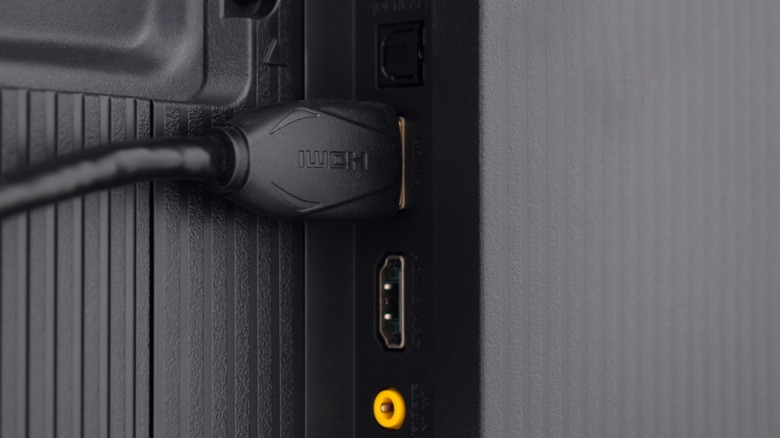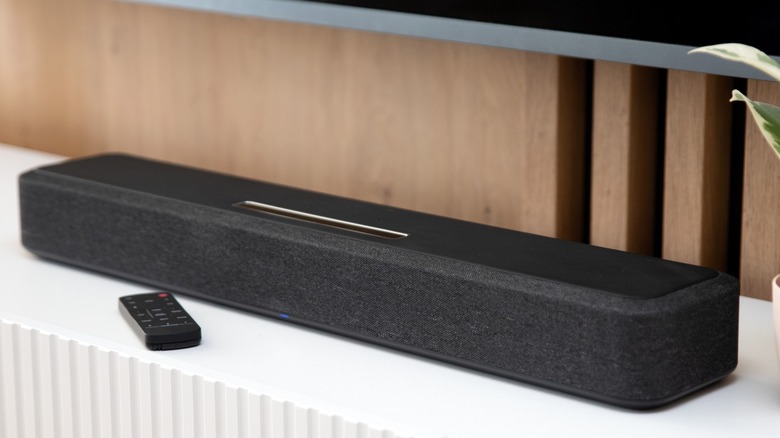Which HDMI Port You Use On Your TV Can Actually Matter
We may receive a commission on purchases made from links.
After spending hundreds or thousands of dollars on a big, nice TV, you'd expect it to blow you away with some crisp, beautiful video quality, You may even have noticed that the fidelity is pretty good when using built-in apps, but your streaming device or console — plugged in through the HDMI port — is a little lacking. That's because HDMI ports matter; they make a huge difference depending on what port you use for connectivity.
Apart from quality, other things like refresh rate (which affects smoothness of playback) and even audio capabilities are heavily determined by what kind of HDMI port you choose. Some HDMI ports come with extra features you may even have taken for granted, such as ARC/eARC, HEC, CEC, HDR, VRR, ALLM, etc. Yes, that's a lot of abbreviations, but we'll give you the gist so you can properly understand what exactly your HDMI port has and adjust your entertainment setup for the most optimized connectivity.
What are the types of HDMI ports?
While all HDMI ports look alike, the version of HDMI they use makes a huge difference. HDMI 1.4 tops out at 4K 30Hz or 1080p 60Hz, HDMI 2.0 bumps things up to 4K 60Hz with HDR, and HDMI 2.1 unlocks 4K at 120Hz, 8K support, eARC, VRR (Variable Refresh Rate), and ALLM (auto low-latency mode). It's worth noting that while ALLM is an HDMI 2.1 feature, it's backward compatible with 2.0 and is subject to whether manufacturers add it to their TVs and supported devices.
If you're connecting something like a PS5, Xbox Series X|S, or Apple TV 4K, plug it into an HDMI 2.1 port to take full advantage of those features. For gamers especially, HDMI 2.1 enables smoother gameplay, less input lag, and future-proofed performance. Unfortunately, some TVs don't label their HDMI versions clearly, but you can usually spot HDMI 2.1 where you see an eARC tag. In cases where there isn't any label, you should try the first port in the row.
That said, you'll need the right HDMI cable. Not every cable can handle the bandwidth that HDMI 2.1 demands. Just to be safe, you should buy the highest bandwidth cable you can find. All HDMI cables are designed to be backwards compatible, and the older cables aren't much cheaper, so there's no real advantage to buying them. For less than $9, you can get a 6ft Amazon Basics HDMI 2.1 cable right now and avoid any compatibility issues.
Audio quality depends on the right HDMI port, too
While HDMI is mostly known for video, it's also responsible for carrying audio. Depending on which port and HDMI version you use, you could be missing out on much better sound.
Most TVs today support ARC (Audio Return Channel), which lets the TV send audio back to a soundbar or receiver through a single HDMI cable — no need for a separate optical cable. You can get ARC and great sound quality on HDMI 2.0 and 2.1 through Dolby Atmos and DTS:X, but the newer eARC (Enhanced ARC) is available only on HDMI 2.1 ports.
If you're not using eARC, you might be stuck with compressed audio even if your soundbar can do more. And if you're using an older HDMI port or cable, ARC might not even work reliably. So, if your TV has one HDMI port labeled "ARC" or "eARC," that's the one you should be using for your home theater system. If you have only one HDMI 2.1 port, and it is also eARC, then you'll have to run your audio using your soundbar's passthrough feature if it supports it.
Bonus tip: If your devices support CEC (Consumer Electronics Control), connecting them via HDMI can also let you control everything — TV, soundbar, and even game console — with one remote.


